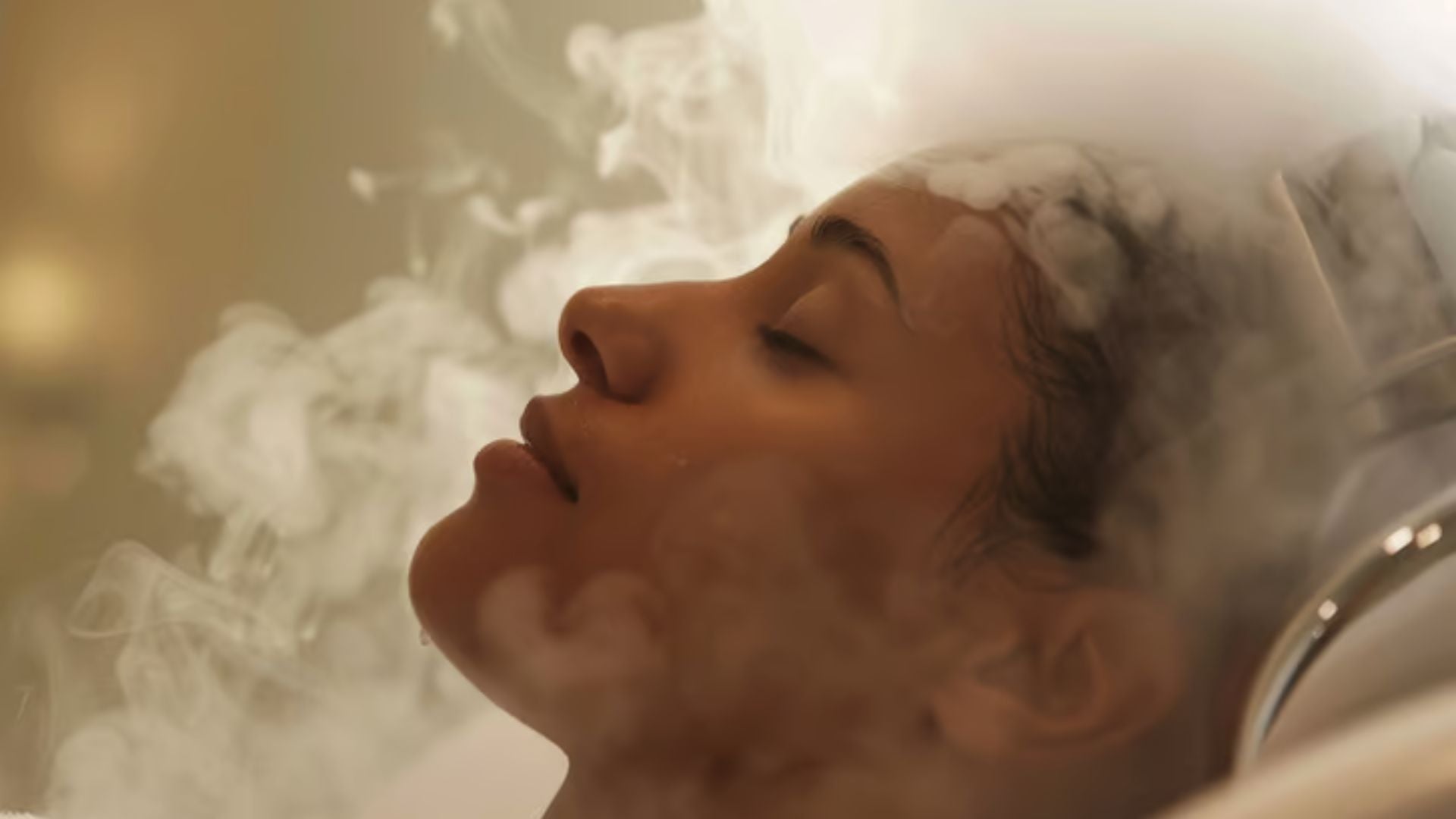The Ultimate Hydration Hack - Salon treatments, at home!
Have you seen those hair spa treatments in salons and thought, “Wow, that looks SO relaxing” but can’t get into the salon? Why not pamper your curls at home?
Here’s an easy and effective way to give those curls extra hydration—while taking five to pamper yourself.
We also caught up with Jonina Menzies to chat about the key differences between steam from humid environments and spa steam treatments designed specifically for hair health.
What Does Steaming Actually Do to Your Curls?
Let’s talk about what’s happening when your curls meet steam.
Your hair shaft has tiny layers, like shingles on a roof. When steam is applied to wet hair, the cuticle layers gently lift, allowing moisture to penetrate deeply into the hair’s cortex. This is different from when your dry curls encounter steam, like in a hot shower—where the sudden exposure to moisture swells the outer layer, causing frizz.
Why Steaming Improves Long-Term Hair Health
Steaming does more than just make your curls feel soft in the moment. Over time, consistent steam treatments:
-
Help improve moisture retention
-
Strengthen the hair shaft
-
Reduce breakage
-
Enhance elasticity (hello, bouncy curls!)
-
Improve product absorption for better results
Professional Steam Treatments for Curly Hair
In salons, steam treatments work by gently opening the hair’s cuticles, allowing moisture to penetrate more effectively. The process starts with freshly washed, damp hair, followed by the application of warm, humid air. This is often combined with a deep conditioning treatment to maximise hydration and nourishment, leaving curls softer, healthier, and more manageable.
Five Benefits of Steaming Your Curls
-
Deep Hydration – Helps combat dryness by infusing moisture into the hair shaft.
-
Better Product Penetration – Allows conditioners and treatments to work more effectively.
-
Increased Elasticity – Reduces brittleness, making curls more flexible and bouncy.
-
Less Breakage – Keeps the hair stronger and less prone to snapping.
-
Softer, More Defined Curls – Hydrated curls = happy curls!
What Hair Types Benefit the Most from Steaming?
While all curl types can benefit from steam, it’s especially great for:
-
Type 3 & Type 4 curls – These textures tend to struggle with moisture retention, and steam helps deeply hydrate.
-
Coarse hair – Steam makes it easier for products to penetrate thick strands.
-
Colour-treated or damaged hair – If your curls have been through heat styling or colouring, steam can help replenish lost moisture.
DIY Steam Treatment at Home (LOHY. Edition!)
Want to recreate a salon-style steam treatment at home? LOHY. has made it easy with our Cold Shoulder Guard. With the right techniques you can create a gentle steam experience right from your couch. Here’s how:
What You Need:
-
LOHY. Nourish& Flourish Shampoo and Drench & Quench Rich Conditioning Hair Mask
-
LOHY. Detangling Flexi Brush
-
LOHY. Cold Shoulder Guard
Step-By-Step:
-
Cleanse Twice – Start with a thorough cleanse using Nourish & Flourish Shampoo to remove buildup and prep your hair for hydration.
-
Condition & Detangle – Apply Drench & Quench generously and use the Detangling Flexi Brush to distribute evenly.
-
Heat Your Cold Shoulder Guard – Dampen it, then pop it in the microwave for 30 seconds. Use a heatproof bowl for this step.
-
Wrap & Relax – Place the warm Cold Shoulder Guard around your curls like a loose turban.
-
Pamper Yourself – Find a comfy spot, sit back, and let the steam work its magic for 15-20 minutes.
-
Rinse & Style – Rinse out the conditioner, style as usual, and enjoy your ultra-hydrated curls!
Steaming your curls doesn’t just feel luxurious—it’s a game-changer for hydration and curl health. Whether you’re treating yourself at a salon or recreating the experience at home, your curls will thank you for the extra TLC!
* If your curls don't style the same post treatment - don't panic!! This is totally normal and can be your hairs response to deep hydration. Give it a day or two, it will settle!
Lets talk Steam Spa's - 5 Minutes With Jo!
To eliminate any confusion, we asked the expert (Jonina Menzies) to weigh in on the differences between Steam Spa Treatments and Frizz from Humid environments.
In this conversation, Jonina breaks down the difference between the controlled hydration of a steam spa treatment and the frizz that can happen when you're in a humid environment like a sauna or a steamy shower.
Louise: So, what's the difference between the frizz we get when we walk into a sauna, gym shower, or any humid environment and the effect of a steam treatment?

Jonina: Great question! The key difference is how moisture is interacting with the hair.
The first difference is wet hair. When you’re doing a steam treatment—especially with conditioner or a treatment in your hair, your hair needs to be soaking wet—the steam is working to soften the hair and push hydration deep into the hair strand. It acts like a drawcard, infusing moisture into the hair’s cortex. This is particularly beneficial for people with low porosity hair, meaning hair that naturally resists absorbing moisture. These are often tighter curl types, like 3C-4C, where water tends to bead off the hair even after swimming or showering. The steam helps overcome this resistance and allows hydration to penetrate deeper.
But when you walk into a humid environment like a sauna or steamy shower with dry hair, it’s a completely different process. In this case, your hair has already been styled, and you've likely sealed in hydration with your products. Remember, no matter how much moisture you've locked in, hair will still react to its environment.
When you're exposed to high humidity, the moisture in the air disrupts the balance in your hair. Your hair will start pulling in moisture from the air, causing the cuticle to swell, leading to frizz, flyaways, and puffiness. It’s not the same controlled hydration you get from a steam treatment—it’s external moisture invading your hair structure.
Louise: Are there ways to prevent this from happening while using high humidity areas like saunas or spas?
Jonina: Not entirely, BUT if you frequently use saunas, you can reduce frizz by covering your hair with a cozy, then a shower cap. This will help to retain internal hydration.
Different types of saunas also affect hair differently. Traditional saunas use heated stones with water to generate steam, whereas infrared saunas heat the room differently, causing sweating through infrared heat rather than direct moisture. Either way, heat causes moisture loss, which is why protecting your hair in these environments can help.
Louise: So steam treatments are good for the health of your hair, but not necessarily something you want to be doing right before a night out?
Jonina: Exactly. Steam treatments are amazing for hair health, longevity, and hydration—but they’re not about styling. If you’re going for maximum volume, definition, or long-lasting hold, excessive hydration might not be what you need right before an event.
Louise: So it's a bit like skincare, like facial peels or micro-needling? Amazing for your skin’s health, but not something you would do before heading out the door?
Jonina: Yes, that's right. Think of it like skincare: a deep hydration facial can do wonders for your skin, but you wouldn’t do it right before applying a full face of makeup. The same goes for hair. Steam treatments can make hair more hydrated and manageable, but they can also reduce the need for heavy styling products because your hair is naturally holding onto more moisture.
If you’re planning a big event, consider doing a steam treatment a couple of days beforehand, so your hair can fully absorb the benefits without affecting styling.
At the end of the day, it’s all about balance—hydration for health, but strategic timing for styling!
Love & Hydration Xx



BIG News: Our Mini Range Just Got A Major Upgrade!
Which LOHY. Hair Gel is Right for Your Hair?